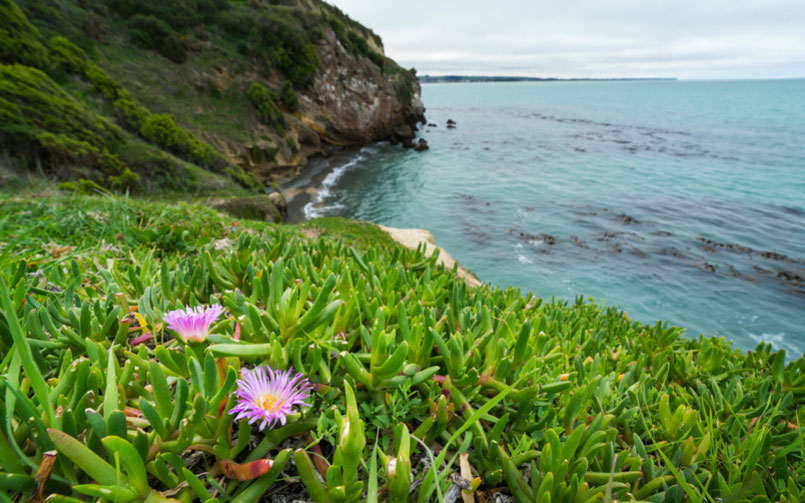Coastal landscaping must be hardy to endure harsh seaside weather with high wind, moisture, and salinity levels. From planters to lampposts, to a seaside fire pit, everything must be designed to endure unique coastal conditions. Here are some coastal-friendly landscaping solutions to inspire your renovation.
#1. Pick Hardy Plants
The most important rule of thumb with coastal landscaping: pick hardy plants. Native plants are a big bonus too because they naturally thrive in the area without human intervention. AKA—they are incredibly low maintenance and well-suited to the unique coastal conditions.
Luckily, there are a variety of hardy (and native) plants out there—many of which are surprisingly beautiful and delicate. Take the African Lily, for instance, which can tolerate wind and salt spray. In the winter, it makes a great indoor plant placed near a sunny window.
Other hardy coastal plants include Lady’s-Mantle, Allium, Bleeding Heart, Anise Hyssop, Flowering Tabaco, Annual Poppies, Russian Sage, and Veronica ‘Sunny Border Blue.’ Ornamental Grasses make excellent filler plants for coastal landscapes. Perennials, along with native trees and shrubs are smart bets for coastal landscaping success.
Check plant hardiness levels to ensure they are compatible with the conditions of your coastal environment.
#2. Tackle Extreme Weather with Mulching
Along with careful plant selection, CoastalLiving.com recommends employing adequate mulching techniques. To prevent plants from freezing and then thawing in the winter, cover them with extra spruce boughs towards the end of fall. This keeps plants dormant. Interior designer and coastal gardening expert Mallory Marshall told Coastal Living she collects seaweed from the beach and uses it as mulch—giving plants a boost of boron, iodine, and more. Even better, slugs don’t like it so they find another garden to munch on.
#3. Consider Every Season
The goal is for coastal landscaping to look good all year long. To accomplish this, it’s important to pick a variety of foliage that blooms at different times throughout the year. Then, plant in accordance so that something is always blooming with color somewhere. Even in a harsh coastal environment like Maine, this is possible. Look at native plants to get inspired, but don’t be afraid to look towards non-native species as well.
#4. Gravel is Great Groundcover for Coastal Environments
A combination of gravel, crushed rock and sand makes great groundcover for coastal landscapes. For one, it can help with drainage, and two, it can endure the wind and other elements without much impact.
#5. Add a Water Feature
Add a water feature to the entrance of the property to tie in the tranquil sea theme you’ve got going on. Consider adding lily ponds as a low-maintenance type of outdoor fountain.
#6. Checkered Pattern Concrete & Grass
Plant rows of grass in between concrete squares to line a courtyard or seating area. This softens the space and builds a naturally elegant style. You could use real grass, but faux grass is much easier to maintain and less likely to interfere with the longevity of concrete squares.
#7. Pick Planters & Site Furnishings Built Tough
No landscape is complete without planters and site furnishings. Keep in mind, average planters, receptacles, and lighting fixtures are not built to endure harsh coastal climates. Ours are. From planters to lighting fixtures, TerraCast’s resin-based blend is proven to outlast the competition regardless of weather or climate. Plus, all our products are made right here in the USA using sustainable practices.
Shop durable planters for coastal landscapes
#8. Stick to Low-Lying Foliage
Keep your garden foliage neat and tidy with low-lying plants that highlight the ocean view without getting in the way of it. Vines, plants with large leaves, and soft flowers are all great options to create atmosphere that doesn’t take anything away from the natural beauty of being on the coast.
#9. Bright Lighting Solutions
There are specific lighting regulations for coastal homes and businesses to protect the local environment and wildlife. Additionally, you’ll need lighting fixtures that don’t rust or corrode when exposed to high moisture and salinity. Your standard metal pole encaged in concrete is going to rust within a short time, pretty much as soon as moisture seeps through the porous concrete and reaches the metal core.
TerraCast Lighting fixtures are coated in a signature resin-based blend for superior protection against the elements. Non-porous and non-hydroscopic by nature, our lighting fixtures do not absorb moisture or salt and are resistant to cracks and other common forms of damage.

